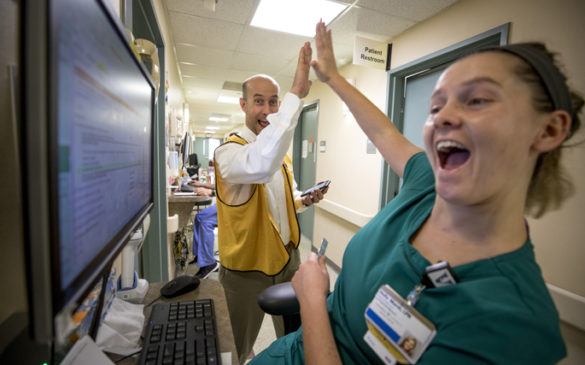
Last week Vanderbilt University Medical Center (VUMC) switched to a new computer system for electronic health records, ordering of tests and drugs, supporting inpatient and outpatient care delivery, billing and other hospital and clinic operations.
The move to eStar, as the new system is called, affects some 18,000 network application users at Vanderbilt, as well as patients who use the My Health at Vanderbilt web portal to review records and interact with the health care team.
With the Nov. 2 activation of eStar, an operational command center and a separate technical command center have been operating around the clock, and hundreds of eStar trainers have fanned out to hospital units, clinics and backend offices to provide at-the-elbow support to users.
“All in all, looking broadly at VUMC, we’ve had a good start to this major transition,” said Kevin Johnson, M.D., M.S., Senior Vice President for Health Information Technology. “For one thing, we’ve had far fewer system-to-system communications issues than we would have anticipated.
“As always with a project of this scope, when you’re dealing with 18,000 people who have varying degrees of skill, our job is now to get them all up to the level of mastery, and that’s going to take a little while.
“We’re doing what we can to minimize frustration and anxiety. Our people are used to delivering the highest quality of care, and we are working all day and night to resolve problems.”
According to Johnson, the Go Live phase of EpicLeap, as the massive software implementation project is called, will last about a month.
“Go Live is concerned with getting the system up and running, making sure we’re delivering care safely, making sure the hospital and clinic are generating charges, making sure our users are getting support as they make this transition,” he said.
Ensuring adequate user support looms as a chief focus at this early stage.
“We made a decision to let some people go who had come from around the country to help us with support, because we didn’t think that they were providing adequate support for our clinicians,” Johnson said.
Replacement trainers began arriving Nov. 6.
Another issue at this stage is helping users get familiar with the electronic health record message basket feature.
Focused training on message baskets and other eStar tools is available; employees should watch for EpicLeap communication for details on user labs; clinicians who want practice with message baskets or other skills they learned in training can access the eStar Playground.
By early December it’s anticipated that the Medical Center will have transitioned from the system’s Go Live phase to a stabilization phase of EpicLeap, with Emergency Department patient throughput and hospital and clinic patient volumes having returned to normal.
“Stabilization will be a one- to three-month phase where we’ll focus on any needed work-flow repair, adjusting clinical content, making sure all the end-user devices — workstations, barcode devices, printers — are working as they should, and anything else that our users tell us needs fixing,” Johnson said.
“Surprisingly, we’re already thinking about workflow, clinical content and end-user devices, so we’re already in the middle of stabilization activities during our Go Live period.”
Once stabilization is complete, eStar will be subject to continuous improvement. “We’ll know we’ve reached continuous improvement when we are fixing more things than people are reporting,” Johnson said.
For more information visit the EpicLeap website (employee login required).












